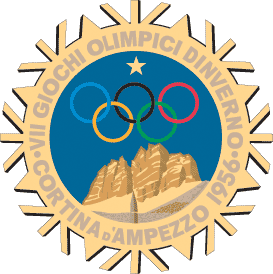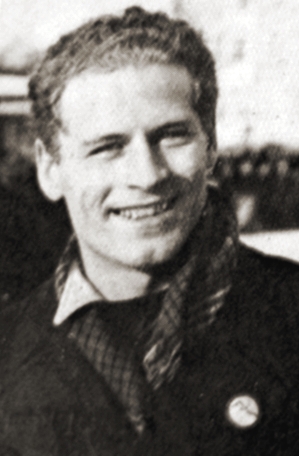
Nordic combined is a winter sport in which athletes compete in cross-country skiing and ski jumping. The Nordic combined at the Winter Olympics has been held since the first ever Winter Olympics in 1924, while the FIS Nordic Combined World Cup has been held since 1983. Many Nordic combined competitions use the Gundersen method, where placement in the ski jumping segment results in time (dis)advantages added to the contestant's total in the cross-country skiing segment.

The 1952 Winter Olympics, officially known as the VI Olympic Winter Games and commonly known as Oslo 1952, was a winter multi-sport event held from 14 to 25 February 1952 in Oslo, the capital of Norway.

The 1960 Winter Olympics were a winter multi-sport event held from February 18 to 28, 1960, at the Squaw Valley Resort in Squaw Valley, California, United States. The resort was chosen to host the Games at the 1956 meeting of the International Olympic Committee (IOC). Squaw Valley was an undeveloped resort in 1955, so the infrastructure and all of the venues were built between 1956 and 1960 at a cost of US$80,000,000. The layout was designed to be intimate, allowing spectators and competitors to reach most of the venues on foot.

The 1956 Winter Olympics, officially known as the VII Olympic Winter Games and commonly known as Cortina d'Ampezzo 1956, was a multi-sport event held in Cortina d'Ampezzo, Italy, from 26 January to 5 February 1956.
Nordic combined at the 1976 Winter Olympics, consisted of one event, held from 8 February to 9 February at Seefeld.
Nordic combined at the 1980 Winter Olympics, consisted of one event, held from 18 February to 19 February. The ski jumping portion took place at Lake Placid Olympic Ski Jumping Complex, while the cross-country portion took place at Lake Placid Olympic Sports Complex Cross Country Biathlon Center.
Nordic combined at the 1984 Winter Olympics, consisted of one event, held from 11 February to 12 February. The ski jumping portion took place at Igman Olympic Jumps, while the cross-country portion took place at Igman.
Nordic combined at the 1972 Winter Olympics consisted of one event, held from 4 February to 5 February. The ski jumping portion took place at Miyanomori Ski Jump Stadium, while the cross-country portion took place at Makomanai Park.
Nordic combined at the 1968 Winter Olympics consisted of one event, held from 10 February to 12 February at Autrans.

Stanisław Marusarz ; 18 June 1913 – 29 October 1993) was a Polish Nordic skiing competitor in the 1930s.
Nordic combined at the 1948 Winter Olympics consisted of one event, held from 31 January to 1 February. The ski jumping portion took place at Olympiaschanze St. Moritz, while the cross-country portion took place around the hills of St. Moritz.
Nordic combined at the 1960 Winter Olympics consisted of one event, held from 21 February to 22 February. The ski jumping portion took place at Papoose Peak Jumps, while the cross-country portion took place at McKinney Creek Stadium.
Nordic combined at the 1964 Winter Olympics consisted of one event, held 2–3 February at Seefeld in Tirol.

Poland first participated at the Olympic Games in 1924, and has sent athletes to compete in every Summer Olympic Games since then, except for the 1984 Games, when they were part of the Soviet-led boycott of the 1984 Summer Olympics. Poland has also participated in every Winter Olympic Games.

Trampolino Olimpico Italia is a ski jumping hill (K90), built in 1955 in Cortina d'Ampezzo, Italy. It was the site of the ski jumping, Nordic combined (K90/15.0) and team events for the 1956 Winter Olympics. The Nordic combined event used a shorter in-run to allow average jumps between 60 and 70 meters while the upper starting points on the in-run were calculated to allow jumps of 70 to 80 meters. The 1956 profile had a safety limit of 14.5 m beyond the critical point of 72 m.. Among many national and international competitions starting with the 1927 World Championships, was the inauguration of the FIS Ski Jumping World Cup in 1979. Since the venue lost its FIS-certification in 1990, the installation lies dormant. In its day, the Cortina Ski Jumping hill was regarded as one of the most innovative and still today as one of the most architecturally beautiful examples still in existence. The stadium holds a maximum of 40,000 spectators in the arena and an additional 10.000 in the stands on each side of the hill.
The Men's individual Gundersen Nordic combined competition for the 2006 Winter Olympics was held in Pragelato, Italy. It took place on 11 February.
The Men's team Nordic combined competition for the 2006 Winter Olympics was held in Pragelato, Italy. It was originally scheduled for 15 February, but high winds meant that only part of the ski jumping competition was completed on that day, with the conclusion, and the cross-country race, taking place on 16 February.
The men's 15 kilometre cross-country race at the 1956 Winter Olympics was held on 30 January. It was held at the Snow Stadium, which was about 2 km (1.2 mi) from Cortina. Sixty-one competitors from twenty countries participated in the event. The Nordic countries of Norway and Sweden took first and second in the form of Hallgeir Brenden of Norway and Sixten Jernberg of Sweden. This was Jernberg's second silver medal of the Games. Soviet skier Pavel Kolchin won his second bronze of the Games.

The "Giuseppe Dal Ben" Ski Jumping Arena is a ski jumping venue in Predazzo, Val di Fiemme, Trentino, in northern Italy. It is a venue in the FIS Ski jumping World Cup.








